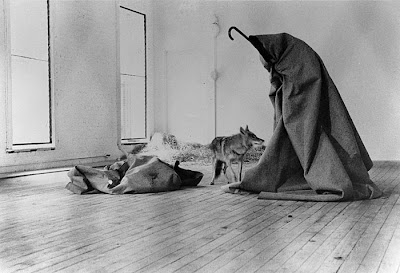Every day we walk through the same spaces. We move from the bedroom into the living room, in and out of the front door. There is the same train to work, the same train home. Objects are rearranged, they appear and disappear. The impression changes with weather and light, from morning to evening, and subjectively with our moods, but mostly our relationship to the places we inhabit is one of reiteration, one of appearance repeated again and again until we cease to even recognize their forms.
Which is why, as I stared into the glass-top table of a softly lit cafe, I was so stunned to see a world I'd forgotten about.
Like so many children, I'd spent what seemed like hours looking at the world upside down. Lying, feet up, on a worn armchair, I saw an entirely different room than the one I ran and played in.
Looking into the reflection on the tabletop, I was looking into a portal, a portal on another reality, and a portal on a reality I once held dear. Here were hanging lamps standing as straight as crinoids on the sea floor, fluorescent light fixtures like low-slung Japanese tables, the long white rectangular benches formed by ceiling beams, clocks tapering at a downward facing noon.
The world as I knew it was full of scattered things, stacks of books on coffee tables, dusty lines of ash gathered around the hearth. But the inverse possessed clean lines and spare white corners and immaculate 90 degree angles. Every object accreted into a ceiling, something you only noticed if you looked up. And the inverse was not so much a true inversion as an abstraction. Suddenly, everything was stripped of its conventional meaning and reduced to an inscrutable form with the texture and shape of modern sculpture.
It was a sort of space I only associated with the museum, a chilly and sparse emptiness filled with holy relics. And so when I went into the inverse, I was entering into a very personal museum, the air conditioning turned on too high, filled with the faint, smoky smell of a disused fireplace in summer.
As I grew older-- too tall and ungainly to curl up on a beat up antique chair, too busy to spend my time in a fantasy-- I stopped staring into the inverse. But occasionally I would get a glimpse.
There was Joseph Beuys, with his crude assemblages of felt and rough-hewn pine standing isolated in a white gallery. And that, of course, was my parents' threadbare rug and the stacks of firewood in a tarnished brass carrier.
There was René Magritte, an impeccable composer of steam trains in bourgeois parlors, sunny days by the Côte d'Azur during which pieces of balsa are conjured up in thin air, lonely poplar trees that seem to grow on other planets, their leaves lit by strange moons.
And there was Giorgio De Chirico, with his empty piazzas and cylindrical towers, casting long shadows on an eternal late afternoon in a nameless Italian town.
What binds them all is a sense of the metaphysical. Narrative is absent. In its place is an infinite spiderweb of signifiers and signified, automatic response, hidden meanings, miscommunication, unsolvable mystery, structures as peculiar as the constellations, painted faces as enigmatic as playing card royalty.
Of course our aesthetic sense changes over the course of a lifetime. But there are certain things we can trace to specific initial events. I walk through the halls of museums in London, Saint Louis, Kuala Lumpur, down white passageways, past massive plate glass windows and Barcelona chairs. I stop before paintings and video loops, and I can look at them, appreciate the technical effort of their composition, fix their place in the continuum of art history. But then I stumble upon something. And suddenly, I'm transported to the imaginary museum, and I'm face to face with inverse reality. Once, I used to hide there.
Thursday, January 24, 2013
Subscribe to:
Post Comments (Atom)





No comments:
Post a Comment